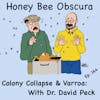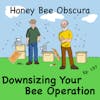Rim, Feeding Rim or Spacer (089)

So, what’s that thing you put between two supers to give additional space between top bars below and bottom bars above so there’s room for…something you want to add to the hive. Is it a spacer, a rim, or what? Kim has always called it a...
So, what’s that thing you put between two supers to give additional space between top bars below and bottom bars above so there’s room for…something you want to add to the hive. Is it a spacer, a rim, or what?
Kim has always called it a ‘rim’ and thought he had one until this week. Because it’s getting time to think about winter feeding, and he always used a rim to make room for the pollen patties he feeds, couldn’t find it. He looked in a few catalogs, but could not find them listed.
Jim simply calls it a ‘feeding rim’, not just a ‘rim’ and you can find those, he says. In fact, they are easily made!
So what else are rims, or spacers used for in a beehive? Turns out there are lots of uses with just minor tweaks here and there! Listen today to learn what Jim and Kim find out about something as simple as a rim or feeding rim or spacer.
We hope you enjoyed today's episode. Please follow or subscribe today and leave a comment. We'd love to hear from you!
___________________
Thanks to Betterbee for sponsoring today's episode. Betterbee’s mission is to support every beekeeper with excellent customer service, continued education and quality equipment. From their colorful and informative catalog to their support of beekeeper educational activities, including this podcast series, Betterbee truly is Beekeepers Serving Beekeepers. See for yourself at www.betterbee.com
______________________
Honey Bee Obscura is brought to you by Growing Planet Media, LLC, the home of Beekeeping Today Podcast.
Music: Heart & Soul by Gyom, All We Know by Midway Music, original guitar music by Jeffrey Ott
Copyright © 2022 by Growing Planet Media, LLC

Episode 89 – Rim, Feeding Rim Or Spacer
[music]
Kim: Jim, I'm getting ready to do some fall feeding, and I think I'm going to have to use a pollen patty on one of my colonies. I put a pollen patty on, and then I put a rim on top of the box so that there's space for the pollen patty, and I can't find it anywhere. I went looking, and it wasn't there. I opened up a couple of the catalogs that I've got here, and I looked under rims if I could even have a search, and I didn't find rims. What do I do now?
[music]
Jim: Oh, Kim, let me think just for a second. What do you do now? Either build it yourself or find the one you lost. I don't know that they're even for sale. Let's talk about it.
Kim: Hi, I'm Kim Flottum.
Jim: And I'm Jim Tew.
Kim: Today, we're going to talk about, well, I guess, rims or whatever they are.
Introduction: You are listening to Honey Bee Obscura, brought to you by Growing Planet Media, the folks behind Beekeeping Today podcast. Each week on Honey Bee Obscura, hosts, Kim Flottum and Jim Tew, explore the complexities, the beauty, the fun, and the challenges of managing honeybees in today's world. Get ready for an engaging discussion to delight and inform all beekeepers. If you're a long-timer or just starting out, sit back and enjoy the next several minutes as Kim and Jim explore all things honey bees.
Kim: I just thought everybody had them. Everybody talks about it. Yes, you put a rim on you, you got some space to put things in, and you close it up, and the bees take it from there, but it seems to be not that simple.
Jim: Well, yes and no. First of all, I'm not a spacer expert or a rim expert. Could I just say that right upfront?
Kim: Yes, you can.
Jim: But I've got a history with these things. When you say it's not in the catalog, yes and no, because when you do anything to the simple devices, they're the same size as the equipment. They're usually 3/4 inches square stock and the same dimensions as the equipment. If you do anything else to them, the name changes. I don't know if the name changed and you're looking up rim or spacer, and in reality, it's going to be a feeder spacer or something.
They're so easy to build, but they're weak to build because if you make them out a 3/4-inch stock, that tiny little board isn't really very powerful, so it racks and twists easily. I find these things really useful, Kim. Number one, for exactly what you're talking about, for adding temporary space in the colony. Where do you find in the catalog? I don't know if it's even in the catalog.
Kim: Well, I don't build things. A hammer in my hand's a dangerous weapon, usually on my own self. I got one way back when I started using 8-frame equipment, because a 10-frame rim, spacer, whatever you're going to call it, isn't going to fit my 8-frame equipment, and I've used it. Every time I needed one, it was there. Not there this year. Where do I look?
Jim: Okay. You're asking me that question again. I didn't know the answer the first time. [laughs] I don't know. Should I grab a catalog right now while people wait and let's look through this if I had a feeder rim? I would call it a feeder rim because if you cut a notch in it, then it's an upper entrance rim.
It all depends on how we're going to go with this thing, let's start at the very simplest level, and that would be what you want to do it for. You know what I've used those for in the past was, like you said, for putting on a pollen patty or a feed cake. Sometimes I've used it for things like laying a piece of that cloth up there to see if I could catch small high beetles using that microfiber cloth. Anytime I wanted an extra space in the colony, I'd put that little rim on.
Now, I built mine, Kim. On one hand, it's so simple to build that it's hard to build because the joints are so weak. Screw, glue, whatever you want, nothing's going to hold up. Be careful with the thing. I got them in the bee yard right now, and I hang them on the fence, so they're out there all the time and protected.
I don't know if you can buy it or not. I tell you, at the end of this thing, I'll try to build you one, but I'm going to need the dimensions for eight-frame. Since I don't use that, read between my lines, I don't have an eight-frame layout for it. I'm going to want to tell you a short story about this whole feeder spacer, rim thing, whatever. On the very first day, number one, first day that I went to my class, my first bee class at Auburn, way back in the early '70s, the professor was running a table saw, and he was cutting deeps down to the depth of a medium because he said he was too old to use those heavy deeps. You and I have talked about that.
There, he had a pile of these rims piling up on the floor. As the class ended, he just casually said, "Does anybody want these things?" Well, of course, I do. I want everything beekeeping, even the garbage. I loaded up 20 or 30 of these things, and they lasted me for years. I never really built them. They were deeper. They were about 2 inches deep. They weren't like the upper entrance rims or the other things that we've talked about, but they had all kinds of uses. That was where I got my first supply of rims that lasted me for years, was the cutoffs, the scrap from cutting those things down. You're exactly right. If you want to store queens, if you want to feed, this extra space is really useful.
Kim: When you put that extra space on there, somewhere, bee space is being violated, right?
Jim: Oh, it's not violated. It's totally destroyed. [laughs] There's a difference. Yes, anybody who's listening right away, it's probably just itching to get to a phone to call us to tell us that we're dumb as hammers, and we are. If you put those things on, if you put on any variation of a spacer or a rim or whatever, and leave it on during a nectar flow, you're going to have a deluxe mess.
These items usually come into play either after the flow is peaked and the super above it is already full, then you put one on. The bees are not as eager to fill that in. They still will, but you don't leave it on. This is not a permanent piece of equipment. Yes, and every case, every variation on a theme that involves these rims will result in burr comb being built if you leave it on during a nice, good flow.
[music]
Betterbee: Hey, podcast listeners. Here's what we've been waiting for all year long. It's time to harvest and extract the honey. When you're ready to bottle and sell your crop, head over to betterbee.com. There, you can shop for custom honey labels and glass or plastic honey containers. As your partners in better beekeeping, Better Bee does all the work of figuring out the weight each honey container will hold, not just the standard water weight or volume measure. You can choose from the classics or go bold and different with a great selection of uniquely designed bottles. Check out our 50-plus container options and order with confidence at betterbee.com.
Kim: One thing that happened to me a long time ago using what I call a rim is that I forgot to take it off. It stayed in that hive all winter and into the spring. When I got out there for my first spring inspection, they had propolized it and filled it with burr comb to the point where it almost took dynamite to get it off, to separate it from the box that was sitting on in the box that was sitting on top of it. There's the lesson to be learned with that thing. I've seen people use rims, and they wrote about it, and they put a board, essentially put a roof on top of the rim, and they filled it up with the candy that you make candy boards out of. Have you ever done that?
Jim: I have done that. I made them deeper than 3/4 of an inch. I made them closer to 1 inch to a 1 1/2 inch. You can take a variation on a theme here with that rim that now has a plywood back on it. You can use it not only for a feeder board, but you can also put a piece of absorbent cloth on it and use it as a bigger fume board, as a repellent board, where you put all the smelly stuff if you're inclined to use that to repel bees from the supers. You see, then it's no longer called a rim, a feeder rim or whatever, then it's a repellent board in that case. It really depends on what you've modified.
Along that same line, since we're just doing this as we go along, if I took those rims that I had all those years ago at Auburn, one of the things I did with them was put screen, windows screening on the top and just tacked it on with this compression tacker. Then, voila, I had a screened entrance moving device to close a colony up to move it.
Kim: Oh, yes.
Jim: Now, when I did that, anybody trying to do that, don't use a readily available fiberglass window screening because it sags when the bees hang on it, and on its own way, it'll sag. I needed to use aluminum screening, and then as years passed, I went the whole way to eight-mesh hardware cloth and made heavy-duty moving screens out of that.
Kim: Did you use that screen on both sides of that box that you made or just one side?
Jim: Now, I don't know if you're trying to trick me or not. No, just on one side, but Kim, if I put screening on both sides of the spacer and then put a notch in it, then I would have this thing called a double screen. The old people called it the Snelgrove Screen, and you could use that to make colony splits. The thought was that the environmental conditions and the larger unit below would percolate up through the double screen to the divide up top. Is that true or not? I don't know. What do you think?
Kim: Well, since I've never done it, I don't know. Let's see it. If you've got a colony below, then you've got essentially a dead space.
Jim: A dead space is a good way to describe it.
Kim: Then you got to colony above that. If you had a queen in that bottom and not a queen in the top, you'd get some kind of behavior thinking. Maybe they had a queen, they just couldn't get to her, or maybe they would start thinking they didn't have a queen. I don't know.
Jim: They say what we're trying to do, what the old guys were trying to do was control humidity and temperature because up top and that new, probably a smaller colony, I was trying to introduce a queen. You can buy those, they're not truly escape boards, but you can buy those double screens in the literature and in the catalogs. They're used from making colony splits. It's nothing more than a spacer rim with screen on both sides, and on a theme now, just to review, if you put the screen on one side, it can be a moving cover for you to use to when you're packing up and moving bees.
I use a rim just to see if they would help wintering. A few winters ago, I put a 2-inch rim up top, and then I put a quilt. It's actually just an old used-up bath towel. I put that on top of the colony to see if that upper insulation would do anything to help the wintering colony. It absorbed moisture. Of course, the bees glued it soundly with propolis to the top bars. The old guys always had insulated tops on those thicker tops that a kind of rim that they had filled up with wood shavings, and this discussion we're having, one of the things you can do is use that spacer up top to provide insulation for the colony.
Oddly, Kim, throughout the entire catalog, there's not a section for spacers or rims or whatever. They're just mixed in here and there. They each have different names. In a strange way, is it a strange way or not, a slatted rack that some beekeepers are really crazy about is just a rim that goes on the bottom board, and it's been modified to have the slats added to it so that the bee space is maintained, but the bees have a place to cluster. Those bees that are matted out front in the weather have a place to hide during the hot summer days when they're out there and the thunderstorms are coming. In a way, that's a spacer, that's a rim on the bottom.
Kim: Well, I'll have to go back to the catalogs and look for something other than a rim that will work as a rim for what I need, I guess, then is what you're telling me.
Jim: Why don't you just give me $25 and I'll build you one and give a couple of years to do it, and this'll have a happy ending? Before we get away from this, I want to tell you this old story. I don't know where I read it. I cannot find it, but I read about a rim, almost 3 inches deep, that went on the bottom and had holes cut in both ends and the sides, large holes. It was called a Bottom Hive Ventilator. Here's the bottom board. On top of that was this bottom hive ventilator. It's not quite the depth of a section super, and it had holes and slots cut in it. Then those holes and slots were covered inside with eight-mesh screen.
The beekeeper's suggestion was that this would, again, like a slatted rack, give the bees a place to cluster. I built one, I put it on, and I did what you and I discussed. The flow's over, the colony is established, there's not a major nectar flow going on. The bees did build what I would call ladder combs to connect the bottom board to the frames above, but they didn't build a lot of it, and they did cluster inside.
Then the famous tornado of 2010 blew through and destroyed everything, to include my only version of that was destroyed. I've got a few pictures of it, but Kim, there is in the literature buried out of sight, a device that goes on the bottom, a very bottom spacer that goes between the bottom board and the bottom deep that has ventilated holes cut in the side.
The suggestion was that it would help the bees control the temperature and give them a place to get out of the hot sun and the thunderstorms that came along. There's just no end of this spacer thing. In a way, an inner cover is a rim that's just filled in. Just like we were discussing a bit ago with the candy boards, an inner cover, it's just a variation on that.
Kim: While you're mentioning, two things just popped in my mind that don't have much to do with what I need a rim for right now, but if you've got a rim up on top that you filled with insulation, then you've got way too much ventilation in the winter. You've got more air coming up there enough to soak that towel you put up there, where if you reduced your entrances down below, you would have much less, if any, ventilation, and you wouldn't need that insulation up on top to absorb water. Insulation to keep it warmer inside, yes, but not to absorb water.
The same thing about that spacer down below. If you've got a great big hole down below, that's just like a big fat entrance that bees don't like, and you see a bee tree, and at that hole is you can't even get your thumb in there because it's so small. A lot of times, that's what they like. That, too, reduces ventilation going out the top of the hive.
I wonder, I can guess why you're there. You're not going to see that bottom one anymore because there's too much ventilation. In the summer when you're trying to cure honey, it's going to be hard to keep it warm enough inside because you got so much outside air coming in, and in the winter, same thing, you've got too much air coming in and it's going to be hard to keep it warm. Don't you think?
Jim: I'd love to argue with you, but I can't because that bottom ventilator did not catch on. You and I both have lived long enough to see beekeeping things that come and go all the time. Maybe that came and went, maybe everything you're saying is right, but ventilating from the bottom has not been. I'm saying that, then I'm wondering about a screen bottom board. If we're worried about ventilating from the bottom, then what in the world does a screen bottom board do?
Let me deal with that thought for a minute. I don't know what to do with that, Kim. [chuckles] We have vast amounts of ventilation coming through a screen bottom board, but the spacing is not thrown off. Anyway, listeners that Ventilator didn't catch on - you decide if you want to go back and look at that idea again or not. I can't find where I found that in the literature.
Kim: I think you're right on things coming and going, because screen bottom orders, you don't see much anymore. That's the reason is because there was too much ventilation on the inside of the hive, in the brood nest. They're trying to keep brood warm, and you have a breeze coming in all the time, but I'm going to take you up on you building me a rim, and I'll come down in a couple years and pick it up.
Jim: [laughs] You buy me dinner and you bring me the dimensions for an 8-frame colony, and I'll make you a 3/4 inch rim. For everybody who's listening, we were just discussing today the whole concept of spacing and rim devices that go in colonies and the different names that we give them when we modify them. That was our intent here today. I use them all the time. They're simple, and they're not always easily defined in the catalog as Kim pointed out, but I'll be sure you get one, Kim.
Kim: Well, that I wanted one tells me that there should be somebody out there that won't charge me $25 to make one, that I can go get one, so I'm going to go look and see if I can find somebody else who's a little less expensive. It's good talking to you guys.
Jim: All right. Had a good time. Bye-bye.
[00:20:30] [END OF AUDIO]
New to Honey Bee Obscura Podcast?
Here are some great episodes to start with. Or, check out episodes by topic.







 So, what’s that thing you put between two supers to give additional space between top bars below and bottom bars above so there’s room for…something you want to add to the hive. Is it a spacer, a rim, or what?
So, what’s that thing you put between two supers to give additional space between top bars below and bottom bars above so there’s room for…something you want to add to the hive. Is it a spacer, a rim, or what? So what else are rims, or spacers used for in a beehive? Turns out there are lots of uses with just minor tweaks here and there! Listen today to learn what Jim and Kim find out about something as simple as a rim or feeding rim or spacer.
So what else are rims, or spacers used for in a beehive? Turns out there are lots of uses with just minor tweaks here and there! Listen today to learn what Jim and Kim find out about something as simple as a rim or feeding rim or spacer.






